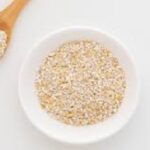by Ocean Robbins: In Greek mythology, Hades tricks the kidnapped goddess Persephone into staying in the underworld with him for part of each year by leaving a bowl of pomegranate seeds at her side…
We are proud to announce a new partnership with John and Ocean Robbins and the Food Revolution to bring our readers Summits, Seminars and Masterclasses on health, nutrition and Earth-Conscious living.
Sign Up Today For the Healthy Heart Masterclass
In that dark, dreary place, the ruby-jeweled fruits would certainly have seemed the most alluring and luscious things in sight. Persephone, according to the stories, nibbled on six of the seeds, which according to a law that I would not want to be bound by, meant that she was obligated to spend six months a year next to her now-husband, the somber god of the dead.
That’s a pretty creepy way to begin an article about one of the best, happiest, and healthiest fruits on the planet: the amazing pomegranate. But wait — it gets worse. Getting its name from the Latin for “apple” (pomme) and “seed” (granatus), the fruit is known in France as “grenade,” and you know where that’s headed.
But let’s leave the talk of abduction and war behind, and focus on all the good things about pomegranates. Because the worst thing that will actually happen to you while you eat a pomegranate is that you might stain your new white shirt.
The Rise of the Pomegranate
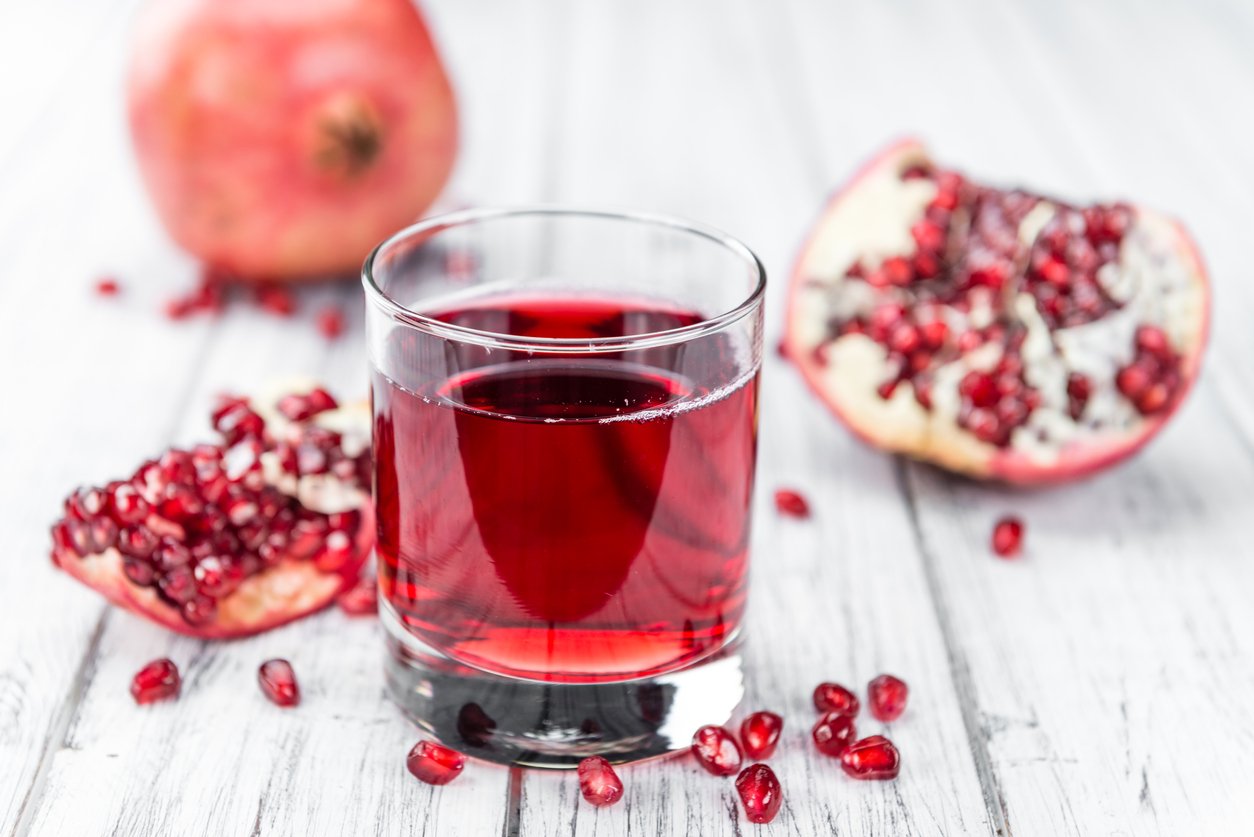
In the year 2000, only around four percent of Americans had ever tasted a pomegranate, but that was soon to change. The pomegranate craze in the United States began that year, fueled by the aggressive marketing and distribution strategies of a California-based company with the modest name “Wonderful.” You may have seen their shapely POM bottle in the grocery store.
Many stores began to carry whole pomegranates, pomegranate juice, as well as containers full of pomegranate seeds. But as you may have noticed, pomegranate products are relatively expensive. Why is that? Well, because even though pomegranates are relatively easy to grow and harvest, it takes intensive processing to remove the arils (or the seeds and red juice surrounding the seeds) from the flesh of the fruit.
While their popularity is newer in the US, pomegranates have a long history of usage in the Middle East, Africa, and Southeast Asia. In 2017, the total world production of pomegranate was estimated at 3.8 million metric tons, evidence of its large consumer demand, which continues to grow as more people discover the delicious fruit.
Even ancient writings demonstrate how popular pomegranates have been in centuries past. Many have described pomegranate as a sacred fruit that provided fertility, abundance, and luck to their people. The pomegranate is also a common symbol used in Armenian and Persian cultures, signifying authority over death and protection against the evil eye. And today, many wellness influencers have bestowed superfood status upon it.
In this article, we’ll look at the science and practicalities of pomegranate consumption. How healthy are pomegranates for you? Is it good to drink pomegranate juice? What about their impact on the environment? And how exactly do you eat one (without making a mess)?
What Are Pomegranates?

The pomegranate is a spherical fruit with a “crown” that grows on a tree originally native to Iran, the Armenian highlands, and northern India. Today Iran, the world’s largest producer of pomegranates, grows over 740 different varieties of the fruit.
Pomegranates are categorized as a fleshy berry (which is easier to say five times fast than I predicted), but they actually belong to their own botanical family, called Punicaceae. While the most common color of pomegranate is red, the fruit also comes in pink, yellow, and white. The fruit’s intense color, and that of its juice, comes from antioxidant flavonoid compounds called anthocyanins. The different varieties of pomegranate also range in flavor from sweet to sour. Sadly, I’ve never come across white pomegranates, which are apparently super sweet compared to their red and pink counterparts.
Have you ever had the urge to count the arils in a pomegranate? Me neither. But an early estimate from the Jewish tradition puts the exact number at 613, which is the same as the number of commandments in the Torah. Hence the fruit is commonly consumed on the Jewish New Year, reminding adherents of their intentions for the coming 12 months. Botanists who’ve counted the arils give a wider range between 200 to 800 — depending on the individual fruit. The clear, reddish fruit flesh of the aril surrounds a tiny, crisp seed, and the whole seed is edible.
Pomegranate Nutrition

Pomegranates are often called nutritional superfoods, and for good reason. They’re high in phytochemicals and antioxidants such as flavonols — and the anthocyanins that give them their pigment. In fact, research has found that the pomegranate has an antioxidant potential even greater than that found in red wine or green tea, two other foods renowned for their superfood status.
These colorful fruits also contain a number of important vitamins and minerals. For instance, they’re a good source of vitamin C, vitamin K1, potassium, and folate. One medium-sized pomegranate offers around 11 grams of fiber. And if you wondered whether fruits have protein, a pomegranate contains a whopping five grams. (Not bad for a fruit that’s also 82% water!)
The seeds encapsulated in the arils also contain a number of antioxidants as well as a unique fatty acid called punicic acid, which may have benefits for reducing inflammation and insulin resistance, according to some animal studies.
Keep in mind that it’s the pomegranate arils — not the juice alone — that provide the fiber and the protein. Plus, when pomegranates are processed into juice, much of their water-soluble B vitamins and vitamin C, as well as some other minerals, are reduced or lost. And while both the arils and the juice contain a considerable amount of sugar, both forms are considered to be low to mid-range on the glycemic index, meaning that they’re not going to spike your blood sugar dramatically after consuming them. Still, I’d recommend eating the whole arils, including the seeds inside, to get the most nutrition.
Pomegranate Benefits
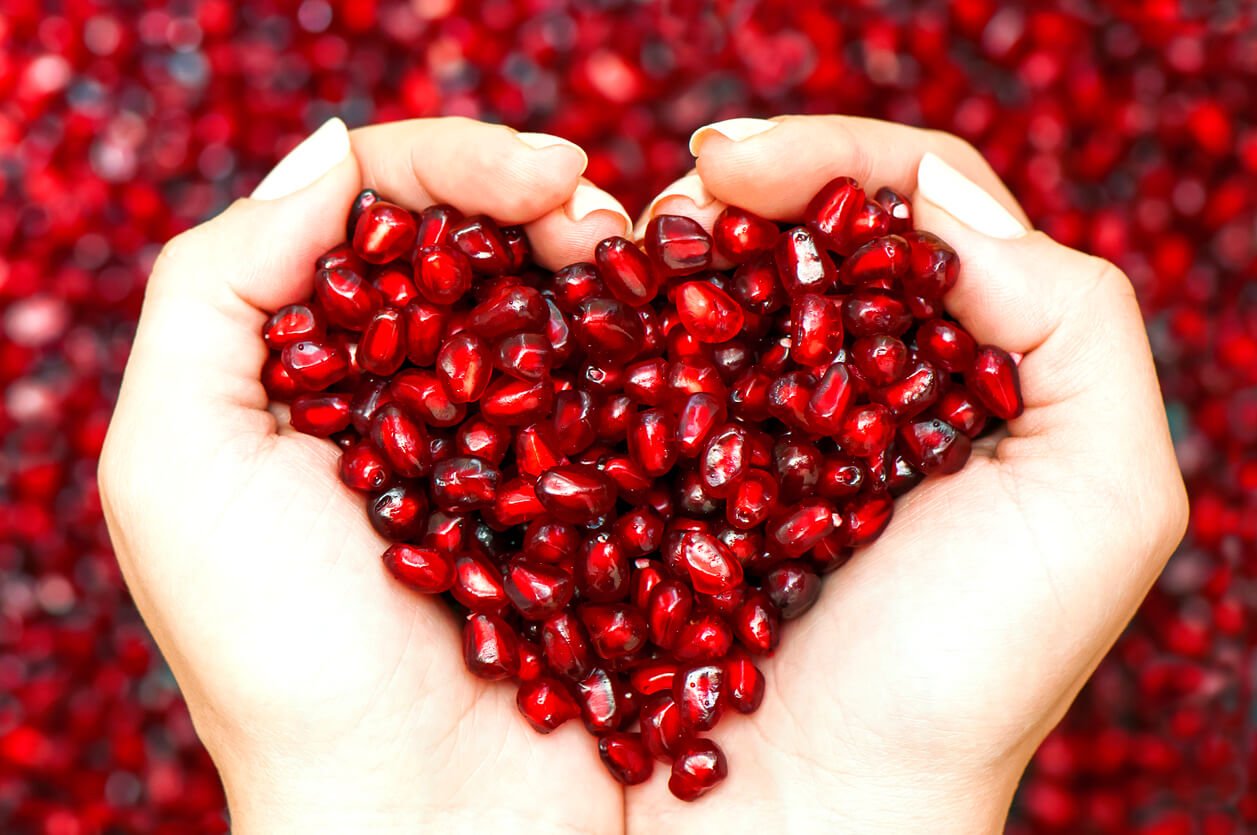
While pomegranates are undoubtedly nutrient-packed, most of the studies conducted on them have either used a fruit extract, pomegranate juice, or a pomegranate seed oil, as opposed to the whole fruit. These studies test the effectiveness of pomegranate compounds against a certain ailment, such as cancer.
Whole fruit extract would likely be the closest thing to eating a whole pomegranate, but the studies may use extracts from arils, the peel, juice, or extracted polyphenols from the fruit. So, while certain beneficial effects from these studies can’t necessarily be applied to the whole fruit, that doesn’t mean including the fruit in your diet is a bad idea. In fact, given what we know about the synergistic effects of the compounds in whole foods, it’s entirely possible (perhaps likely) that eating pomegranate seeds along with the juices surrounding the seeds confers even more benefit than these studies suggest.
Some of the benefits of pomegranate compounds seen in studies include the following:
1. May have anticancer properties.
A number of human, lab, and animal studies have examined the potential role of pomegranate in the treatment of breast, prostate, lung, colon, skin, and liver cell cancers. Pomegranate shows promising anticancer properties, which may come from the antioxidant and polyphenolic compounds in the fruit’s peel, seed oil, and juice.
Pomegranate extract has demonstrated anti-tumor activity in multiple organs and shown cancer-preventive properties. Some animal studies have seen pomegranate extract help inhibit prostate and lung tumor growth. And one human trial found that pomegranate juice consumption helped slow biomarkers of prostate cancer progression. Pomegranate seed oil has also shown promise in preventing colon cancer and reducing breast cancer growth in rat models.
And a 2018 review from Oncology Reviews stated that all parts of the pomegranate have been found to show anticancer activity through a variety of research, and should continue to be studied.
2. May be good for your heart.
Pomegranate juice is rich in polyphenols with antioxidant activity that may be heart protective. Studies have found that they help to prevent the activity of serum angiotensin-converting enzyme (it’s a good thing we don’t have to be versed in biochemistry to reap the benefits of eating healthy food!) and reduce systolic blood pressure — two heart disease risk factors.
The main bioactive component of pomegranate seed oil, punicic acid, has been shown to help prevent the buildup of plaque in the arteries. And a 2010 human study observed the ability of 800 mg of pomegranate seed oil per day to reduce triglycerides significantly among adults with hyperlipidemia.
Other studies have seen two to 14 weeks of pomegranate juice consumption help reduce the formation of LDL (“bad”) cholesterol levels among humans and animals. And in another study, concentrated pomegranate juice given to people with diabetes and hyperlipidemia was able to significantly reduce a number of potentially problematic blood fats. And pomegranate leaf extract given to obese, hyperlipidemic mice for five weeks (I hate to think of what was done to them to make them obese and hyperlipidemic) was able to reduce body weight, total cholesterol, triglycerides, and fasting blood sugar levels.
3. May offer anti-inflammatory benefits.
Many of the health benefits of pomegranates demonstrated in human, lab, and animal studies may be due to the fruit’s anti-inflammatory compounds. Given that inflammation is a key factor underlying most of the major chronic diseases of our times, this is promising news.
One study found that urolithins, compounds made in your gut when you consume ellagic acid (found abundantly in pomegranates), can help inhibit brain inflammation. In fact, the anti-inflammatory benefits of pomegranate may help prevent the development of neurodegenerative diseases like Alzheimer’s. Punicalagin, another polyphenolic compound in pomegranates, may also have anti-inflammatory activity that helps prevent memory impairment.
4. May help improve blood glucose control.
Research has found that pomegranate juice and its components may offer positive effects on blood sugar for some people. The polyphenols and the antioxidant compounds in pomegranates may help to control type 2 diabetes.
For instance, polyphenols in pomegranate juice may help reduce postprandial hyperglycemia (meaning “high blood sugar after eating”), which is linked to type 2 diabetes. Clinical studies among people with type 2 diabetes have also found that pomegranate seed oil can help reduce fasting blood sugar.
5. May be skin protective.
Pomegranate may help protect against sun-induced skin damage, including the risk of skin cancers. In one study, the activities of pomegranate juice, extract, and seed oil were examined against ultraviolet skin damage. All of them appeared to offer protective benefits. And the direct topical application of ellagic acid decreased the production of inflammatory compounds on the skin.
6. May be good for your oral health.
Your mouth is full of germs, but the good news is that eating a healthy diet may keep problematic ones at bay — and pomegranate may help.
One study observed the anti-plaque effects of pomegranate mouth rinse, which could be helpful in preventing cavities. And in another study, a hydroalcoholic pomegranate extract induced an 84% reduction in dental plaque microorganisms.
Environmental Impacts of Pomegranate
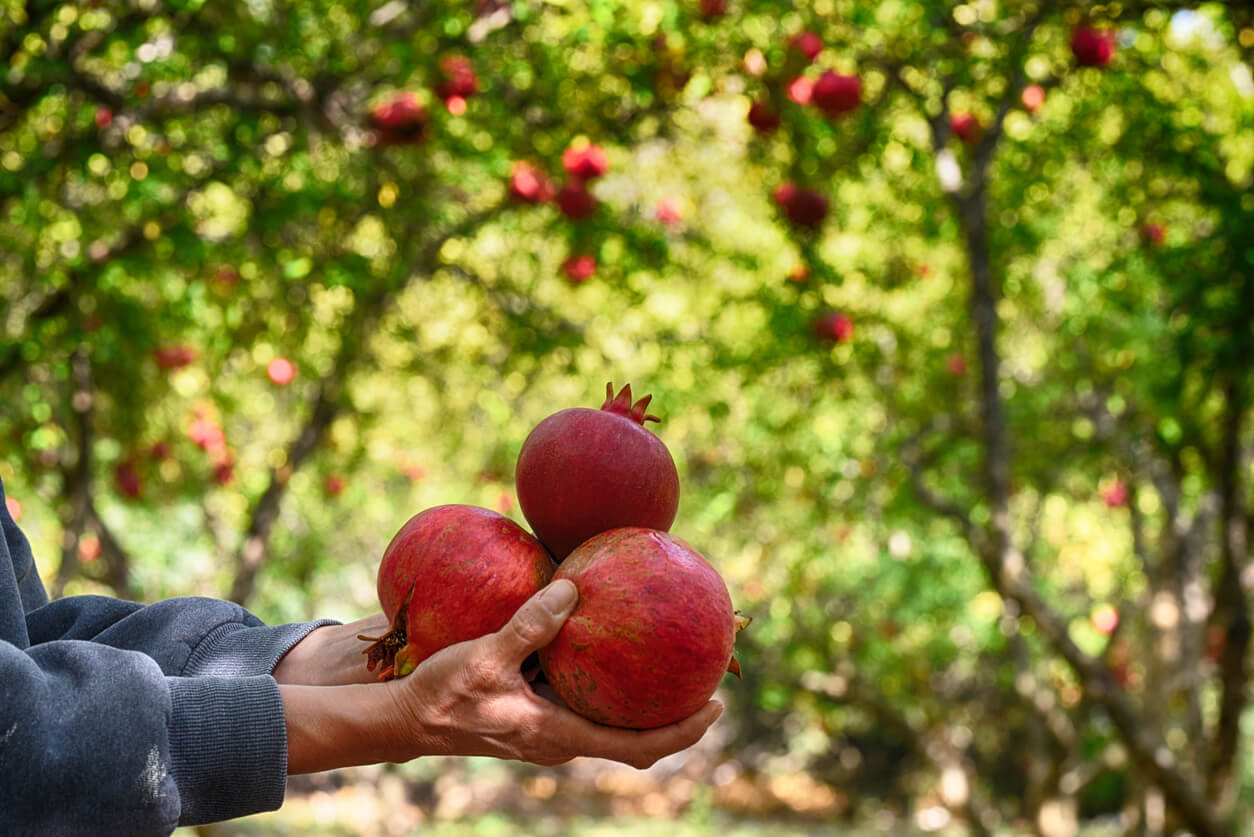
While pomegranates seem to be good for you, are they as good for the environment? Here are some things to consider when purchasing pomegranates.
Pesticides on Pomegranates
Pesticide contamination isn’t a significant issue with pomegranates — at least in the US. The Environmental Working Group, which looks at the safety of conventional produce based on pesticide contamination, has no concerns with the fruit. The pomegranate’s naturally thick skin helps to protect the edible portion of the fruit from exposure to pesticides and other contaminants.
However, there are other reasons to support organic farming whenever you can, such as its impact on soil, air, and water compared to conventional farming, as well as the health of farmworkers. Those still apply, even when the direct benefit of organic to the consumer may be small.
Pomegranate Packaging
As far as packaging, buying the whole fruit is a great way to avoid excess plastic. But it also requires more shipping volume, since a lot of the pomegranate isn’t edible. If you’re planning to juice your pomegranates, then buying pre-juiced pomegranates may actually be more sustainable in the long run.
Pomegranate Sustainability
Pomegranate trees tolerate drought well and can thrive with drip irrigation. However, almost all of the pomegranates available in the US come from California, which faces frequent droughts. Most pomegranate orchards located there use flood or furrow irrigation systems, in which depressed trenches next to rows of trees are flooded with water, which slowly soaks into the soil. This method can be wasteful if it’s not managed properly.
Additionally, it’s worth noting that the US’s largest producer of pomegranate products, The Wonderful Company, has been involved in controversy (and a lawsuit) surrounding the privatization of a major water bank in California used by farmers and the military. The crops in question are pistachios, not pomegranates. But Wonderful Co. may be less wonderful to the environment than their upbeat name suggests. (They also own Fiji water, whose relationship with the people of Fiji is ethically questionable, and which ships water around the world in plastic bottles and runs its production facility on diesel fuel — hardly examples of sustainability.)
Pomegranates & Food Waste
Unfortunately, pomegranate farming also generates a large amount of food waste. Whole fruits are often discarded because of sun damage, which causes the skin to crack, as well as their exposure to a variety of pests, and from loss during transport. As a result, pomegranate waste contributes significantly to landfill waste and pollution. But alternative ways to use otherwise discarded pomegranates are being investigated to help reduce waste, including using their peels as biofuel and compost. I personally think it would be cool if baseballs, basketballs, and footballs used pomegranate skin rather than cowhide.
Pomegranates & Carbon Sequestration
In Peru, pomegranates have been studied, with some promising results, for their ability to help sequester carbon. More work is needed to attain net positive carbon fixation in these agricultural systems, however, since the greenhouse gases released by certain agricultural practices still outweigh the carbon removal impact.
Where to Find Pomegranates

In the US, fresh pomegranates generally become available in September or October and are available until January. But if pomegranate juice is your jam, you can get it year-round in most grocery stores, especially when frozen or otherwise preserved.
In India, pomegranates are in season in the summer through October. Both the whole fruit and its seeds can be found in grocery stores, markets (including farmers markets and bazaars), and community-supported agriculture farms.
Feeling inspired? You might be able to grow your own pomegranate trees, either from a seed or a sapling, although it takes around two years to bear fruit. They grow best in zones 7-10, but can also be grown in containers. In the early years, pomegranate trees generally produce 20-25 fruits per season, but over time this can increase to 200-250 fruits. How many arils is that? According to the number described in the Jewish tradition, it could be north of 150,000!
How to Choose and Store a Pomegranate
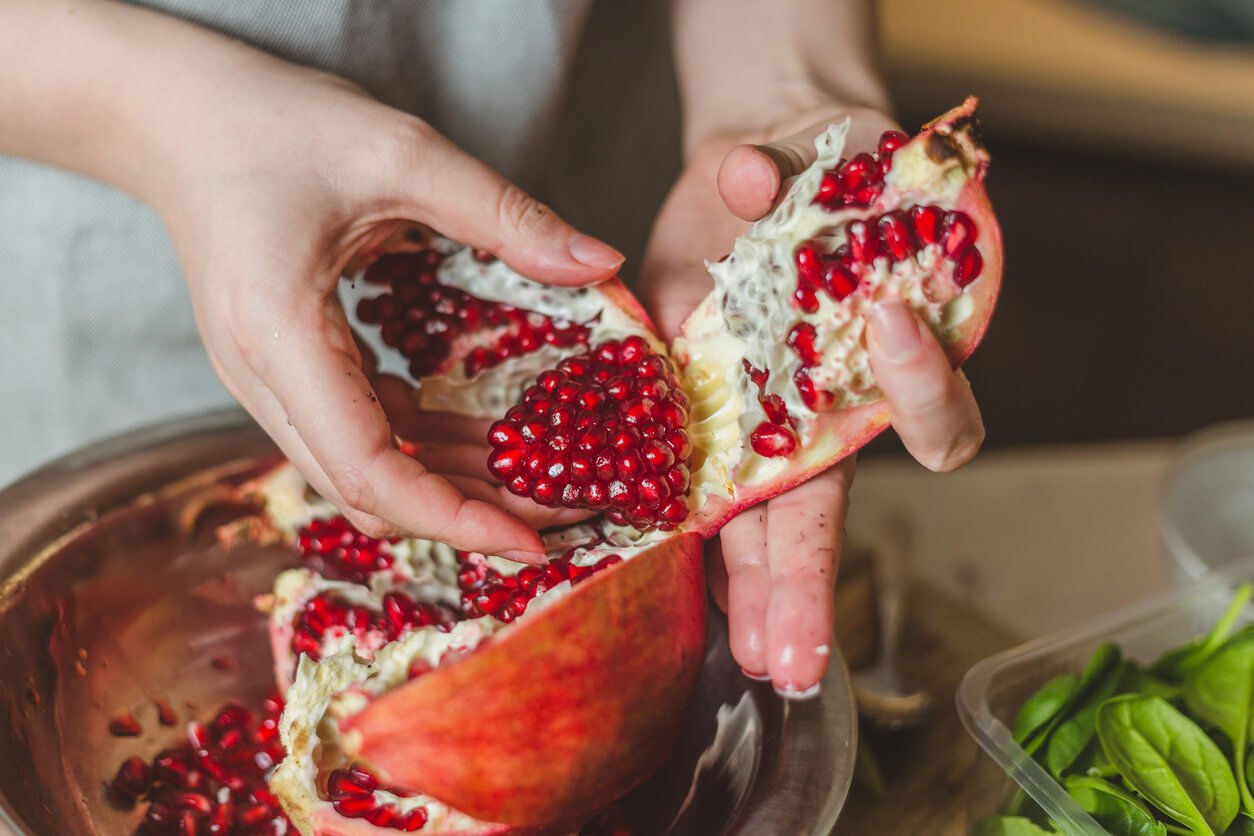
It’s clear that pomegranates have earned consideration for a place in our diets, given their numerous health and nutrition benefits. So how do you choose the best ones and make sure they’re well-preserved?
Look for fruits that feel very heavy for their size, as this indicates a good amount of juicy flesh and seeds on the inside. Avoid pomegranates that have any visible bruises or black spots on their rinds.
Pomegranates have a naturally long shelf-life, and proper storage is key to helping them achieve it. Keep your whole fruits in a cool, dry, well-ventilated place that’s out of direct sunlight. They can also be kept in the refrigerator for up to two months — as long as you don’t store them in a sealed plastic bag.
Once you slice open your pomegranate and remove the arils, they will keep in the fridge for up to five days — as will pomegranate juice. The arils can also be frozen for later use. Just spread them in a single layer onto a cookie sheet lined with waxed paper. Freeze them no more than two hours, and then transfer them to a moisture-proof freezer bag or airtight container for storage. Place them back into the freezer and use them within a year.
How to Open a Pomegranate
Cutting open a pomegranate can be somewhat tricky (which is why it warrants its own section).
To open your pomegranate, start by slicing the top “crown” or knob off with a knife. Approximately an inch below that piece, use your knife to, again, gently slice — but not cut all the way through — a circle around the whole fruit. Think of it as opening a cardboard box that contains something valuable. You want to open the package, not gut the contents. Turn your knife perpendicular to this last cut and put in six to eight more surface cuts to divide the top of your fruit into wedges. Then, using the blade of your knife, and your finger, peel off the wedges of skin to expose the arils and flesh of the fruit.
Once the whole top of the pomegranate is exposed, you’ll see natural divider lines in the flesh between groups of arils. Use your knife to slice downwards along each of these dividers to the other, uncut, end of the fruit. You can then use your fingers to peel off large wedges of the fruit to make a flower-like shape. From here, all of the arils are accessible for you to remove and enjoy!
For you visual learners, here’s a video tutorial on how to get the arils from a pomegranate. I’d skip the move shown at seven seconds where she sticks a knife into her mouth, though.
How to Use Pomegranate
Pomegranate is sweet and delicious. You can use it everywhere, from smoothies to desserts — and even as part of meals.
The juice is wonderful in smoothies, to make tea, incorporated into mocktails, or even used in cold soups like gazpacho. To juice a pomegranate, slice it in half like you would a grapefruit, and use an electric or hand-press juicer. Be careful to avoid juicing the white flesh, as this will change the flavor of your juice and make it bitter. Strain your juice through a cheesecloth to remove any chunks and particles.
You can also make juice by removing all of the arils and adding them to a high-speed blender with some water, combining until smooth, and then straining. Note that if you’re going to juice your own pomegranate, making one cup of fresh pomegranate juice typically requires between two to four fruits, depending on their size.
Pomegranate arils can also be used in a number of ways. You can sprinkle them whole over plant-based yogurt, overnight oats, hot oatmeal, mixed green salads, vegetable side dishes, and whole-grain dishes. They also make a sweet, crunchy addition to fresh salsa and other sauces, dips, and dressings. I love eating them as a snack by the handful, along with some nuts, like a trail mix. And of course, their sweetness goes well with desserts like sweet bread, crisps, tarts, or as a topper for n’ice cream and cakes.
Mouthwatering Pomegranate Recipes
Whether you blend pomegranates into a delicious dressing, add the sweet and tart arils to an earthy kale salad, or infuse your favorite fruit smoothie with pomegranate juice, you’re bound to fall in love with the versatility of pomegranates and the refreshing flavor they offer. The recipes below are straightforward, and each one takes less than 30 minutes to create. Because of this, we suggest trying all three of them!
1. Pomegranate Balsamic Dressing
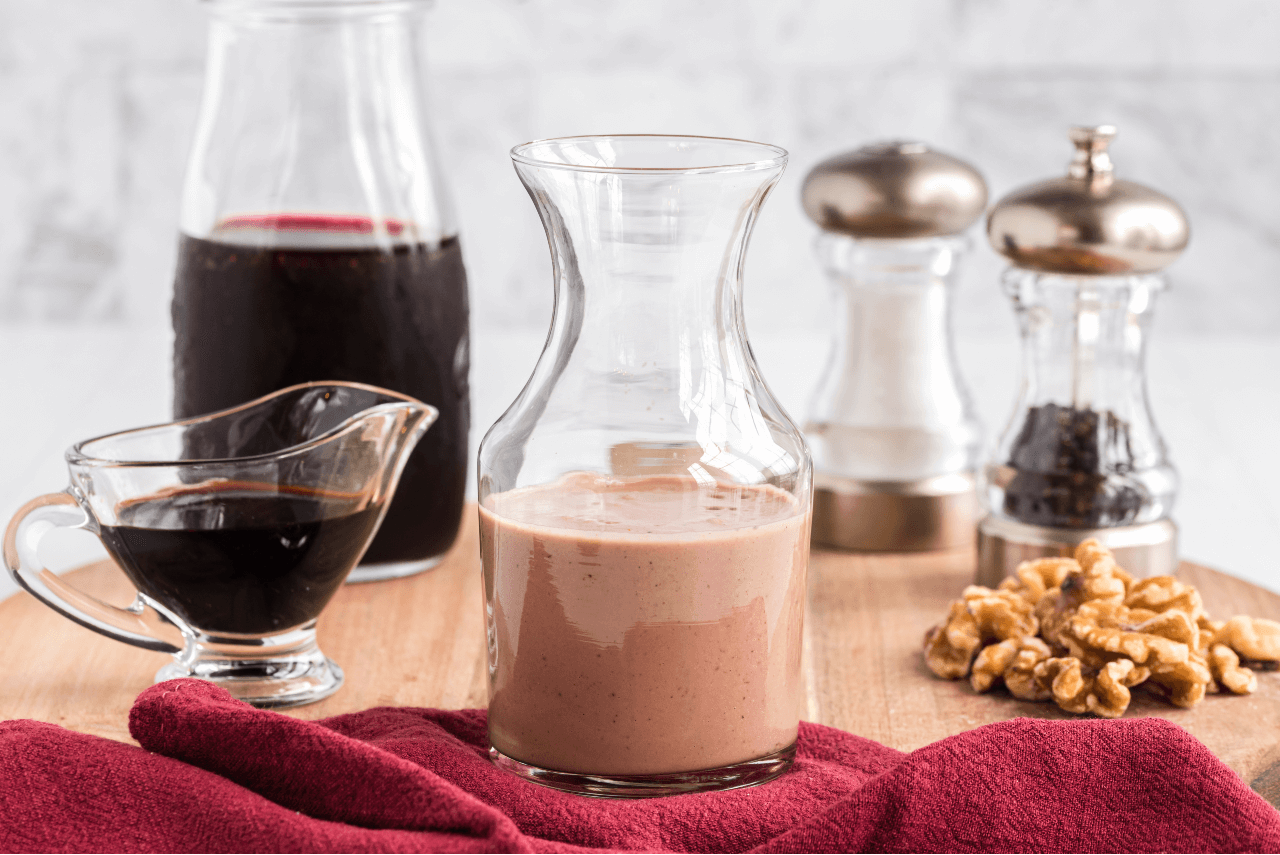
A balsamic dressing packed with superfoods? Sign us up! Pomegranates are a good source of vitamin C, folate, and anthocyanins, while walnuts contain magnesium and vitamin B6. Both are packed with fiber, and there are a few added bonuses. This dressing is light, refreshing, and flavorful! It’s perfect for roasted autumn squash, a winter grain bowl, a spring salad, or grilled summer veggies.
2. Kale Pomegranate Salad with Chopped Walnuts and Sliced Apples
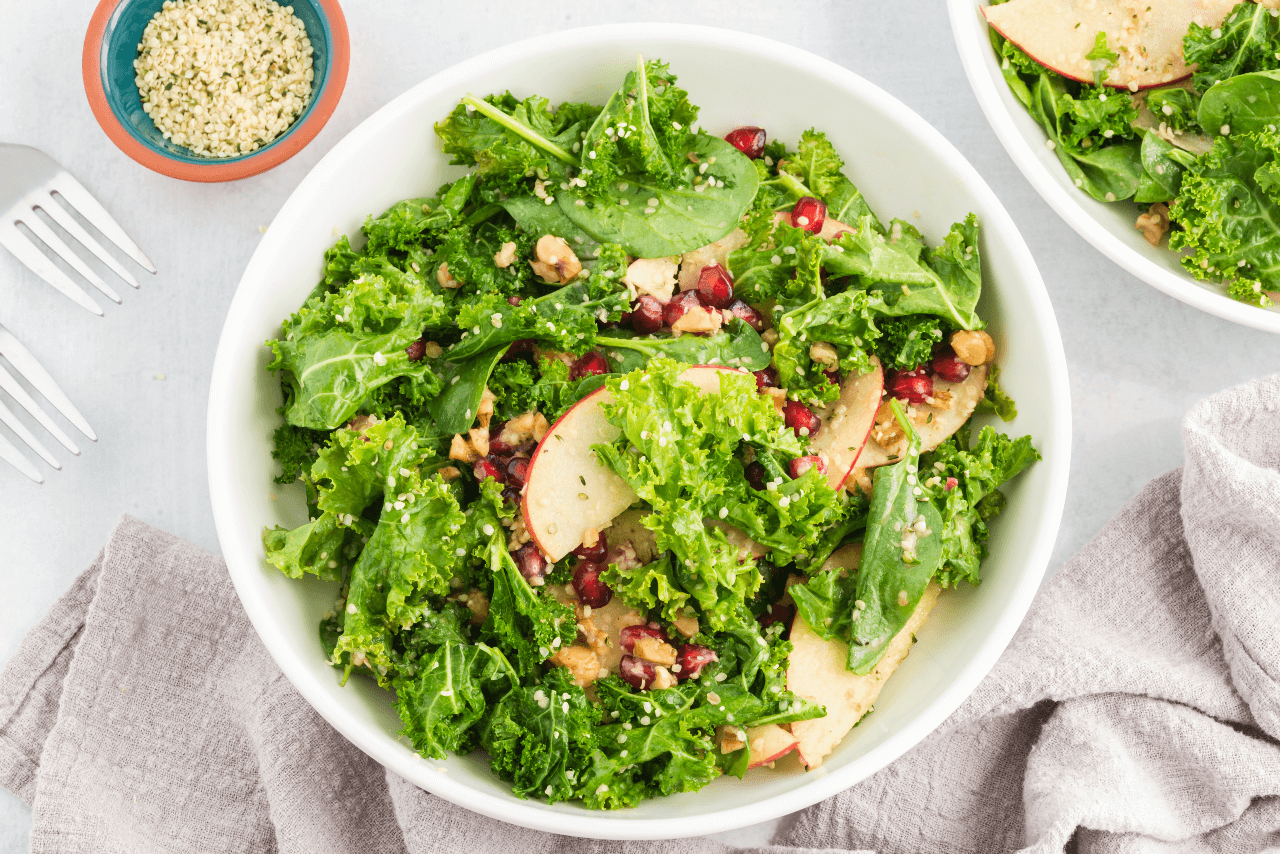
If you’re new to adding pomegranate arils to salads, then you’re in for a treat! Their sweet and tart flavor complements the earthy kale and sweet apples nicely. Plus, they’re light and refreshing, especially next to a hardy green like kale! Enjoy this salad year-round, from a refreshing meal on a summer evening to a colorful dish for a winter holiday party.
3. Pomegranate Poached Pears with Vanilla Cashew Cream
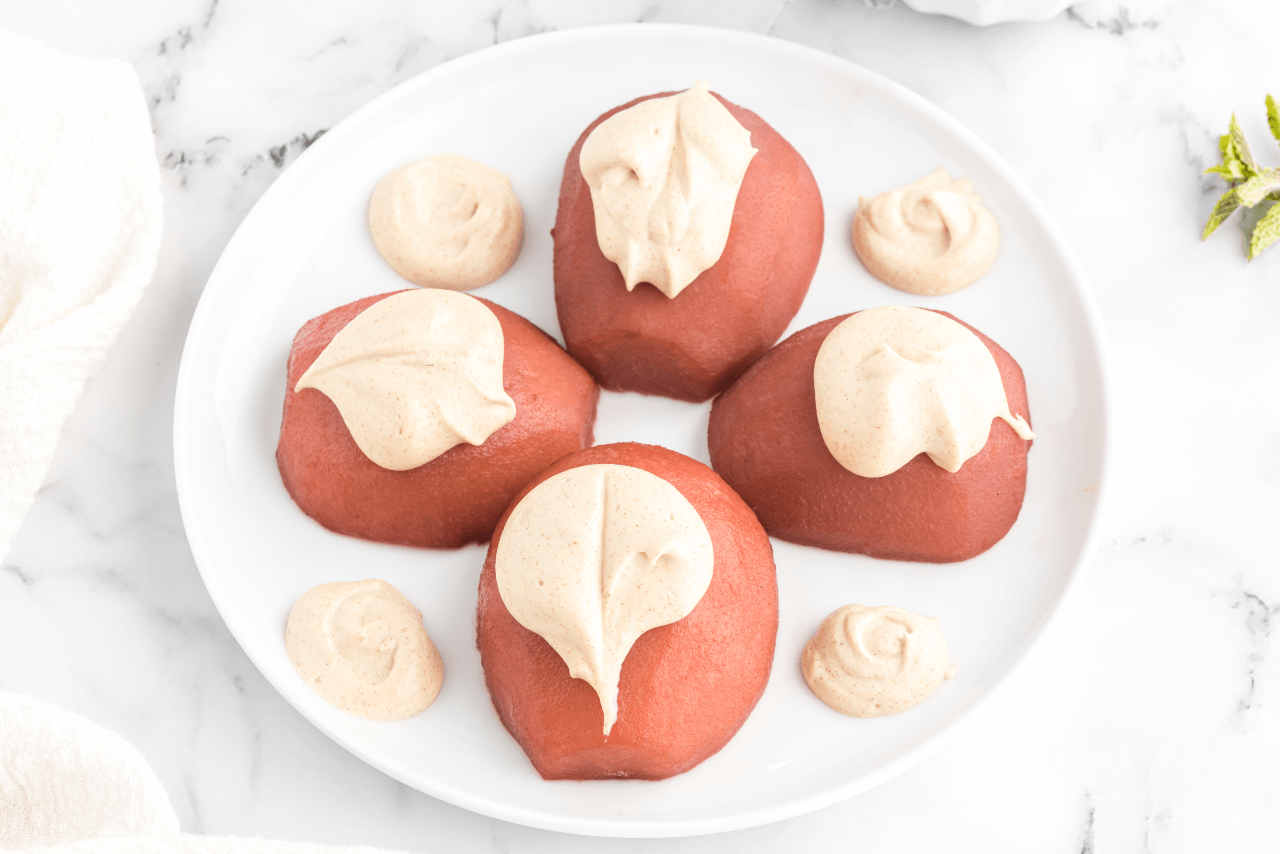
Poaching fruit is a great way to infuse a variety of fun flavors into it, and these pears are no exception. The same method can be used with other fruits, such as apples, apricots, peaches, oranges, and plums. You can even poach dried fruit! Flavorful, antioxidant-rich, naturally sweet treats? Absolutely! P.S. Pair (or pear?) with the Vanilla Cashew Cream for an extra special treat.
Pomegranates Are Beyond Wonderful

The pomegranate is a highly nutritious fruit that has earned its reputation as a superfood thanks to its multitude of health benefits, including its abundant antioxidants. Its juice and seeds also have a number of culinary uses in both sweet and savory recipes. Overall, pomegranate can be a healthy, functional food as part of a balanced diet.








































